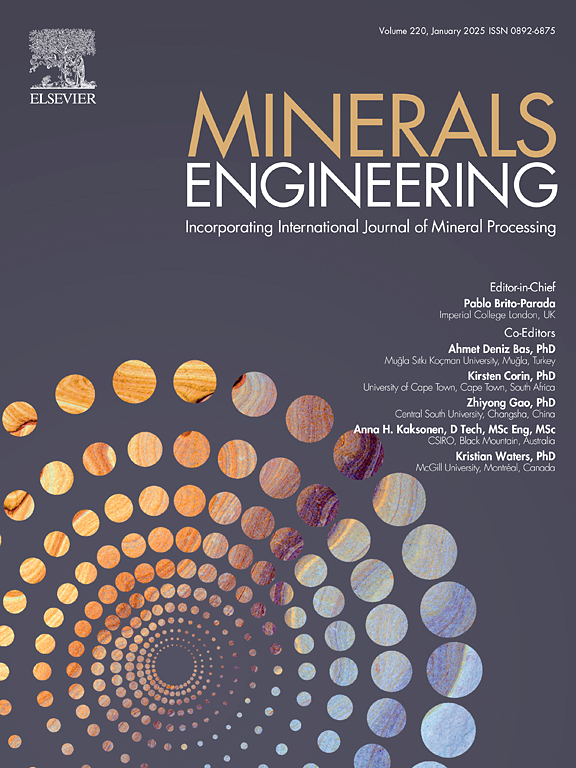Mechanism of pyrite depression by marine Fe(II)-oxidizing bacteria in seawater flotation
IF 4.9
2区 工程技术
Q1 ENGINEERING, CHEMICAL
引用次数: 0
Abstract
Seawater flotation is a promising technique to reduce environmental and economic loads in mineral processing. This study attempted to depress pyrite, a common gangue sulfide mineral, using two marine iron (Fe) oxidizing bacteria (MFeOB), Thalassospira sp. TF-1 and Mariprofundus sp. E-4, in seawater flotation without pH control; the MFeOB could contribute to hydrophilization of the pyrite surface by oxidation and/or adhesion of bacterial cells. Pyrite or chalcopyrite samples were preconditioned in seawater containing MFeOB for different times (15 min or 30 min). As a result of flotation experiments, the recovery of pyrite preconditioned without MFeOB (i.e., control sample) decreased to 64.2 % after 30 min reaction. The same recovery was observed when pyrite was preconditioned with Thalassospira sp. TF-1, whereas the recovery was successfully decreased to 20.2 % after preconditioning with Mariprofundus sp. E-4 for 30 min. X-ray photoelectron spectroscopy analysis of preconditioned pyrite samples showed no significant difference of Fe-oxidizing compounds between with and without MFeOB reaction, suggesting that the formation of hydrophilic substances such as Fe(OH)3 derived from pyrite oxidation by MFeOB is unlikely to be the main reason for the pyrite depression by Mariprofundus sp. E-4. The adhesion experiment revealed that MFeOB cells could cover the pyrite surface but not the chalcopyrite surface, showing that the hydrophilicity of Mariprofundus sp. E-4 cell caused the pyrite depression. This result suggests that the hydrophilic/hydrophobic properties of bacterial cells are a significant determining factor in pyrite recovery in seawater flotation in the case of MFeOB.
海水浮选中海洋铁(II)氧化细菌抑制黄铁矿的机理
海水浮选是一种很有前途的技术,可减少矿物加工过程中的环境和经济负担。本研究尝试使用两种海洋铁(Fe)氧化细菌(MFeOB)(Thalassospira sp. TF-1 和 Mariprofundus sp. E-4)在不控制 pH 值的海水浮选中抑制黄铁矿(一种常见的煤矸石硫化矿物);MFeOB 可通过氧化和/或细菌细胞的粘附作用促进黄铁矿表面的亲水性。黄铁矿或黄铜矿样品在含有 MFeOB 的海水中进行了不同时间(15 分钟或 30 分钟)的预处理。浮选实验结果表明,不含 MFeOB 的黄铁矿预处理样品(即对照样品)的回收率在 30 分钟反应后降至 64.2%。用 Thalassospira sp. TF-1 对黄铁矿进行预处理时,也观察到了相同的回收率,而用 Mariprofundus sp. E-4 进行预处理 30 分钟后,回收率成功降至 20.2%。对预处理过的黄铁矿样品进行的 X 射线光电子能谱分析表明,有 MFeOB 反应和无 MFeOB 反应的黄铁矿样品中的铁氧化化合物没有明显差异,这表明 MFeOB 氧化黄铁矿形成的 Fe(OH)3 等亲水性物质不太可能是 Mariprofundus sp. E-4 抑制黄铁矿的主要原因。粘附实验表明,MFeOB 细胞能覆盖黄铁矿表面,但不能覆盖黄铜矿表面,这表明 Mariprofundus sp.这一结果表明,就 MFeOB 而言,细菌细胞的亲水/疏水特性是海水浮选中黄铁矿回收的重要决定因素。
本文章由计算机程序翻译,如有差异,请以英文原文为准。
求助全文
约1分钟内获得全文
求助全文
来源期刊

Minerals Engineering
工程技术-工程:化工
CiteScore
8.70
自引率
18.80%
发文量
519
审稿时长
81 days
期刊介绍:
The purpose of the journal is to provide for the rapid publication of topical papers featuring the latest developments in the allied fields of mineral processing and extractive metallurgy. Its wide ranging coverage of research and practical (operating) topics includes physical separation methods, such as comminution, flotation concentration and dewatering, chemical methods such as bio-, hydro-, and electro-metallurgy, analytical techniques, process control, simulation and instrumentation, and mineralogical aspects of processing. Environmental issues, particularly those pertaining to sustainable development, will also be strongly covered.
 求助内容:
求助内容: 应助结果提醒方式:
应助结果提醒方式:


